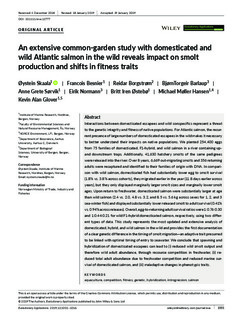| dc.description.abstract | Interactions between domesticated escapees and wild conspecifics represent a threat to the genetic integrity and fitness of native populations. For Atlantic salmon, the recurrent presence of large numbers of domesticated escapees in the wild makes it necessary to better understand their impacts on native populations. We planted 254,400 eggs from 75 families of domesticated, F1‐hybrid, and wild salmon in a river containing up‐ and downstream traps. Additionally, 41,630 hatchery smolts of the same pedigrees were released into the river. Over 8 years, 6,669 out‐migrating smolts and 356 returning adults were recaptured and identified to their families of origin with DNA. In comparison with wild salmon, domesticated fish had substantially lower egg to smolt survival (1.8% vs. 3.8% across cohorts), they migrated earlier in the year (11.8 days earlier across years), but they only displayed marginally larger smolt sizes and marginally lower smolt ages. Upon return to freshwater, domesticated salmon were substantially larger at age than wild salmon (2.4 vs. 2.0, 4.8 vs. 3.2, and 8.5 vs. 5.6 kg across sexes for 1, 2, and 3 sea‐winter fish) and displayed substantially lower released smolt to adult survival (0.41% vs. 0.94% across releases). Overall, egg‐to‐returning adult survival ratios were 1:0.76:0.30 and 1:0.44:0.21 for wild:F1‐hybrid:domesticated salmon, respectively, using two different types of data. This study represents the most updated and extensive analysis of domesticated, hybrid, and wild salmon in the wild and provides the first documentation of a clear genetic difference in the timing of smolt migration—an adaptive trait presumed to be linked with optimal timing of entry to seawater. We conclude that spawning and hybridization of domesticated escapees can lead to (i) reduced wild smolt output and therefore wild adult abundance, through resource competition in freshwater, (ii) reduced total adult abundance due to freshwater competition and reduced marine survival of domesticated salmon, and (iii) maladaptive changes in phenotypic traits. | nb_NO |

